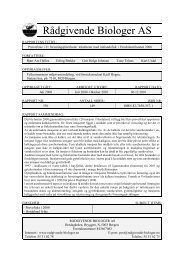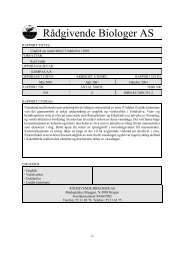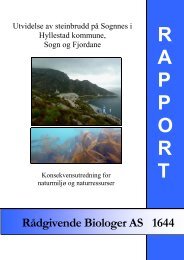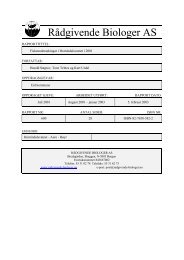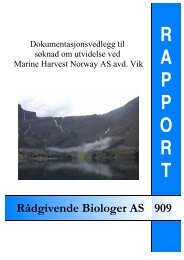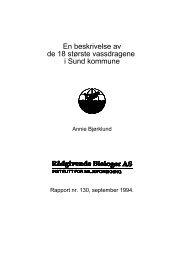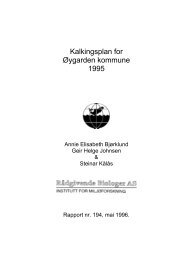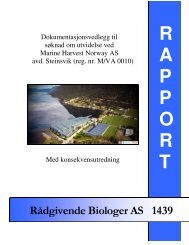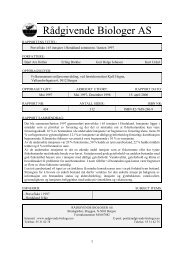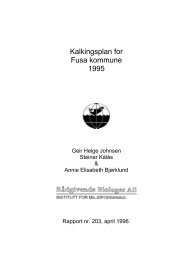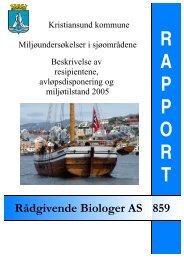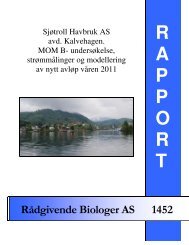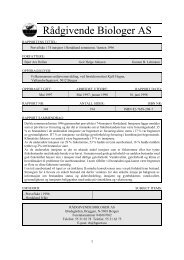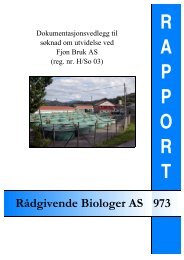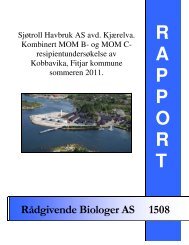Stord kommune. Miljøundersøkelser i sjøområdene. Beskrivelse av ...
Stord kommune. Miljøundersøkelser i sjøområdene. Beskrivelse av ...
Stord kommune. Miljøundersøkelser i sjøområdene. Beskrivelse av ...
You also want an ePaper? Increase the reach of your titles
YUMPU automatically turns print PDFs into web optimized ePapers that Google loves.
ENGLISH SUMMARY<br />
TVERANGER, B., G.H. JOHNSEN & E. BREKKE 2007.<br />
The municipality of <strong>Stord</strong>. Environmental impact assessment of the coastal waters.<br />
Description of recipients, effluent treatement and ecological status 2007.<br />
Rådgivende Biologer ltd., report 1038, ISBN 978-82-7658-565-0, 139 pages in Norwegian.<br />
The Municipality of <strong>Stord</strong> is located on the western coast of Norway and has two coherent and densely<br />
built-up urban areas; Sagvåg with 3.336 inhabitants along the westside and Leirvik with its 10.890<br />
inhabitants situated at the south eastern part. The municipality of <strong>Stord</strong> operates 7 large and 30 smaller<br />
wastewater outlets. The six largest outlets constitute 84 % of the wastewater, and this recipient<br />
investigation focus upon these six largest outlets and the effects they constitute in the marine recipients.<br />
The waste water effluents from two of these outlets, Sævarhagen and Grunn<strong>av</strong>ågen, are released untreated<br />
directly into the sea. In accordance with the Municipality Plan of Sewage Treatment and Water<br />
Environment 2004-2015, these outlets will be upgraded to mechanically treatment. The effluents from the<br />
other four large plants, Frugarden, Djupevika, Kjøtteinen and Kårevik, is mechanically treated before<br />
discharges to the sea.<br />
In accordance with the EEC Urban Wastewater Treatment Directive 91/271, and the Norwegian pollution<br />
authorities, the municipality itself is responsible for authorizing effluents of maximum 10.000 pe to each<br />
distinct recipient, even though it may be discharged from several treatments plants. The urban area of<br />
Leirvik is inhabited by more than 10.000 pe, and will grow together with Sagvåg in the near future. If<br />
these urban areas are regarded as one single unit, an extended level of waste water treatement will be<br />
demanded, and the responsibility for the effluents will be transferred to the County Governour, unless<br />
it can be documented that the effluents are released into several distinct recipients without any mutual<br />
interference. This report presents documentation for this distinction.<br />
According to the divison of water bodies according to the Water Framework Directive, the wastewater<br />
from <strong>Stord</strong> is mainly discharged into four distinct coastal water bodies or recipients, each of which is<br />
receiving effluents from less than 10.000 pe. These are: Husnesfjorden, receiving max 2.300 pe, Leirvik<br />
harbour receiving max 5.000 pe, Klosterfjorden receiving max 6.000 pe and Stokksundet receiving max<br />
3.500 pe (see figure 2 in the Norwegian summary on the subsequent pages).<br />
In 2007, an extensive environmental impact assessment of the coastal waters of <strong>Stord</strong> was carried out to<br />
evaluate both the distinction between the four separate recipients and to settle the approriate extent of<br />
wastewater treatment in accordance to the Waste Water Directive. All results are summarized according<br />
to the EEC Water Framework Directive and presented as classified Ecological Status both in figure 3 and<br />
table 3 on the subsequent pages. The water bodies of Leirvik harbour are regarded as he<strong>av</strong>ily modified<br />
due to extensive physical modifications along ca 50 % of the shoreline, but this is not taken into<br />
consideration when evaluating the Ecological Status.<br />
The investigated water bodies of Husnesfjorden, Klosterfjorden and Grunn<strong>av</strong>ågen in Stokksundet were<br />
scarcely affected by supplies of nutrients, environmental pollutants, and were classified to high ecological<br />
status of coastal surface waters, as well for the biological diversity of soft bottom fauna. Only Leirvik<br />
harbour was classified to good ecological status with regard to occurrence of environmental pollutants<br />
(PAHs and TBT) in the sediments due to adjacent industrial activity. Also the water quality of Leirvik<br />
harbour was moderately affected by intestinal E. coli, and was classified to good ecological status. The<br />
biological diversity of the soft bottom fauna quality in Leirvik harbour was classified to the highest quality<br />
class, but the sediments were from moderately to substansially polluted by environmental pollutants<br />
(PCBs, PAHs and TBT), originating from probably previous effluents from industrial activities as ship<br />
yards and urban activites.<br />
Rådgivende Biologer AS -3-<br />
Rapport 1038



